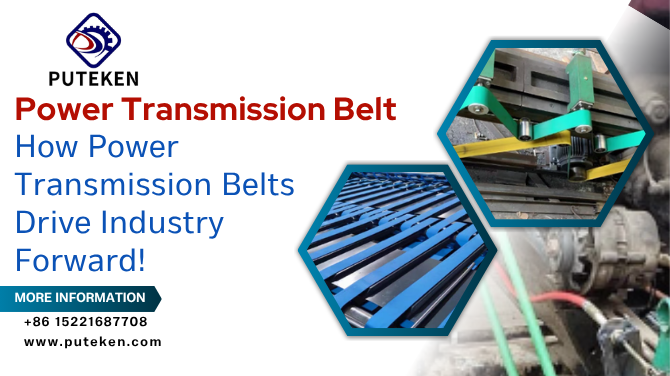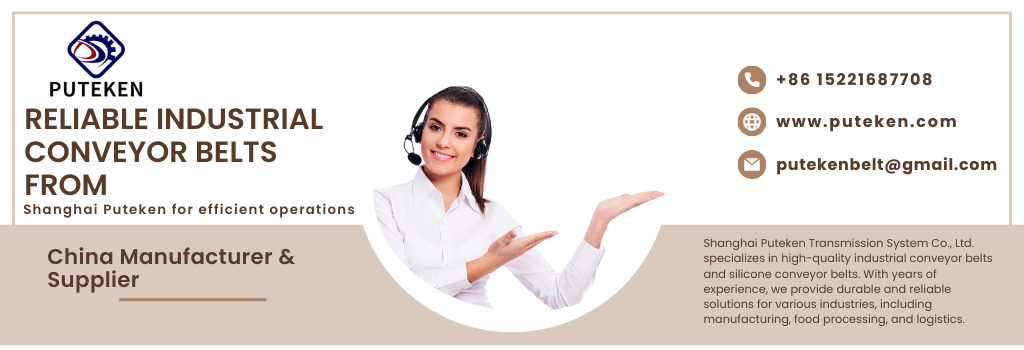
In today’s fast-paced industrial world, efficiency and reliability are everything. Whether it’s a massive assembly line, a precision CNC machine, or a small agricultural tool, one thing remains consistent—the need to transfer mechanical energy smoothly and consistently from one component to another. At the heart of this critical operation lies an often overlooked yet indispensable component: the Power Transmission Belt.
At first glance, it may seem like just another rubber loop, but dig a little deeper and you’ll discover that the Power Transmission Belt is a true workhorse. It’s the silent driver that keeps machines humming, motors running, and industries moving. From manufacturing and mining to automotive and agriculture, these belts are responsible for transferring power between pulleys, ensuring optimal function across thousands of applications.
At Shanghai Puteken Transmission System Co., Ltd., we specialize in providing cutting-edge power transmission solutions that push the boundaries of durability, precision, and performance. As industries evolve and demand greater productivity, our Power Transmission Belts continue to play a pivotal role in driving mechanical success.
What Is a Power Transmission Belt?
A Power Transmission Belt is a flexible loop of material—typically rubber, synthetic, or a composite—that transmits mechanical power between two or more rotating shafts. Unlike chains or gears, belts offer smooth, quiet operation and are ideal for long-distance and high-speed applications.
These belts are used in industrial machines, compressors, engines, HVAC systems, and even everyday appliances. They are the invisible force that transfers energy from a motor to the driven equipment—without slipping, stretching, or failing under pressure.
Why Power Transmission Belts Are Critical to Modern Industry?
Let’s face it—without reliable power transmission, industrial systems would grind to a halt. Here’s why Power Transmission Belts matter:
✅ Efficiency
They deliver mechanical energy with high efficiency (up to 98% in some configurations), reducing energy loss and boosting overall system productivity.
✅ Low Maintenance
Compared to chains or gear systems, belts require less lubrication and upkeep, making them ideal for busy, high-throughput environments.
✅ Vibration Dampening
The flexible nature of belts allows them to absorb shock loads and vibrations, protecting machinery and improving service life.
✅ Noise Reduction
Belts are significantly quieter than chain or gear drives, which is especially important in industries that prioritize acoustic control.
✅ Cost-Effective
Installation is simpler, and materials are typically less expensive, making belts a budget-friendly solution.
Key Components and Design of Power Transmission Belts
Every Power Transmission Belt comprises three main layers:
1. Top Cover
Made of rubber or synthetic material, it protects the belt from wear, oil, chemicals, or environmental conditions.
2. Tensile Member
The core of the belt, usually made of fiberglass, polyester, or aramid cords, provides the strength and elasticity needed to handle heavy loads.
3. Bottom Cover or Groove Pattern
In V-belts or timing belts, this layer provides traction and contact with the pulley system, preventing slippage.
Different applications require different belt constructions, from flat and V-belts to synchronous timing belts.
4. Types of Power Transmission Belts
Understanding the right belt for your application is essential. Here are the most common types:
A. V-Belts
- Named for their V-shaped cross-section
- Offer high power transmission capacity
- Commonly used in automotive and HVAC systems
B. Flat Belts
- Feature a simple, wide, flat surface
- Ideal for high-speed, low-torque applications
- Great for textile, printing, and paper industries
C. Synchronous (Timing) Belts
- Include teeth that fit into matching grooves in pulleys
- Prevent slippage, allowing for precise speed and timing
- Used in robotics, conveyors, and automotive engines
D. Ribbed Belts (Poly V-Belts)
- Combine the advantages of flat belts and V-belts
- Ideal for compact drive systems with multiple pulleys
- Common Applications Across Industries
Let’s explore where Power Transmission Belts shine the brightest:
- Manufacturing
From CNC machines to conveyor systems, belts ensure consistent motion and torque delivery. - Agriculture
They’re used in tractors, combines, and harvesters to transfer power between moving components. - Automotive
Timing belts, serpentine belts, and fan belts are all forms of power transmission belts. - Textile and Printing
Flat belts help run looms, rollers, and drying systems with minimal noise and vibration. - HVAC Systems
Drive fans, pumps, and compressors with minimal energy loss. - Mining and Construction
Heavy-duty belts handle rugged, high-load tasks like crushing, grinding, and drilling.
Power Transmission Efficiency: How Belts Deliver Results
Energy efficiency in belt systems depends on the tension, pulley size, material quality, and belt alignment. When properly maintained, belts can deliver efficiencies as high as 97–98%, outperforming many chain or gear-driven systems.
Shanghai Puteken’s belts are precisely engineered for low resistance, high torque handling, and thermal stability—ensuring your systems consume less energy while producing more output.
Shanghai Puteken: Setting the Standard in Belt Technology
As a trusted supplier of advanced Power Transmission Belts, Shanghai Puteken Transmission System Co., Ltd. offers:
- Premium-Grade Materials: We use high-tensile cords, oil-resistant rubber, and heat-resistant compounds.
- Custom Design Options: Tailored to your machinery and torque requirements.
- Strict Quality Control: ISO-certified processes to ensure consistent product excellence.
- Global Reach: Serving clients in Asia, Europe, North America, and beyond.
Whether you’re building new systems or upgrading old ones, our power belts are engineered to optimize performance across the board.
Belt Maintenance: Tips for Long Life and Reliable Operation
Even the best belts need some TLC. Here’s how to get the most from your Power Transmission Belt:
✅ Regular Inspections
Check for cracks, fraying, or unusual stretching.
✅ Proper Tensioning
Too tight = bearing wear; too loose = slippage.
✅ Alignment Checks
Misaligned pulleys reduce belt life and increase energy usage.
✅ Clean Environment
Dust and oil reduce grip and deteriorate materials.
Innovations in Power Transmission Belts
The world of belts isn’t static. Recent advancements include:
- Antistatic Belts: For electronics manufacturing
- Flame-Resistant Belts: For mining and hazardous environments
- Hybrid Belts: Combine timing and V-belt properties
- IoT-Enabled Monitoring Systems: Detect wear and tension in real-time
At Shanghai Puteken, we’re always innovating to offer our customers the next-generation power transmission solutions.
The humble Power Transmission Belt may not get the spotlight, but without it, modern industry would simply stall. It’s the quiet hero of automation, efficiency, and productivity. From factories to farms, and from engines to elevators, these belts keep our world moving forward.
If you’re looking to upgrade your mechanical systems with reliable, high-performance solutions, Shanghai Puteken Transmission System Co., Ltd. has the expertise, technology, and product range to power your operations to the next level.
Don’t just move—power up. Choose precision. Choose performance. Choose Puteken.
Frequently Asked Questions
Q1: How do I choose the right power transmission belt for my equipment?
A: Consider factors like load capacity, speed, operating environment, and pulley arrangement. Our team at Shanghai Puteken can provide custom recommendations.
Q2: What is the typical lifespan of a power transmission belt?
A: With proper maintenance, a high-quality belt can last 3–5 years or longer depending on usage and environmental conditions.
Q3: Can belts replace chains or gears in existing machinery?
A: Yes, in many cases belts offer quieter and more efficient alternatives to chains or gears.
Q4: Are your belts resistant to chemicals or high temperatures?
A: Yes, we offer specialized belts that are oil-resistant, chemical-resistant, and heat-tolerant.
Q5: Do you offer OEM or custom-designed belt solutions?
A: Absolutely. We work with clients worldwide to design and manufacture custom belts that match unique performance needs.
